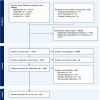Understanding preconception care: a scoping review of knowledge, attitudes and practices among reproductive age individuals, healthcare workers and stakeholders in low- and middle-income countries
- PMID: 40578880
- PMCID: PMC12207119
- DOI: 10.1136/bmjopen-2025-099143
Understanding preconception care: a scoping review of knowledge, attitudes and practices among reproductive age individuals, healthcare workers and stakeholders in low- and middle-income countries
Abstract
Objectives: This scoping review aims to map existing evidence on knowledge, attitudes and practices (KAP) and barriers to preconception care in low- and middle-income countries. The primary objective is to identify key gaps and research priorities to guide future efforts to improve maternal and child health.
Design: This review followed Arksey and O'Malley's scoping review framework, with a comprehensive search across Medline, EMBASE, CINAHL and Scopus from inception to May 2025. Eligible studies included original research on preconception care (PCC), KAP in low- and middle-income countries (LMICs) without date restrictions. Two independent reviewers conducted screening in Covidence. Findings were presented in graphical, tabular and narrative formats, adhering to the Preferred Reporting Items for Systematic Review and Meta-Analysis Protocols Extension for Scoping Reviews (PRISMA-ScR) standard.
Setting: The review focused on PCC studies conducted in LMICs across various healthcare settings, emphasising primary and secondary levels of care. The geographical scope was global but limited to LMICs as defined by World Bank criteria.
Result: A total of 62 studies were included in the review. Of these, 42 employed quantitative methods, 18 used qualitative approaches and 2 used a mixed-methods design. Regarding focus areas, 25 studies assessed knowledge, 14 assessed practices, 12 studies assessed KAP comprehensively and 10 assessed attitudes. Participants were mainly women of reproductive age (44 studies), with only five studies including men. Among healthcare providers, KAP varied, with midwives being the most frequently studied group. Stakeholders such as policymakers were notably under-represented. Identified barriers included limited training, cultural beliefs and inadequate policies. Facilitators highlighted were targeted education, spousal support and policy advocacy, emphasising the need for gender-sensitive and systemic interventions.
Conclusion: LMICs face complex challenges in utilising PCC, influenced by socioeconomic, cultural, and healthcare system factors. To address these challenges, nuanced approaches incorporating intersectional perspectives and practical qualitative methodologies are essential for improving couples' and child health outcomes.
Trial registration number: The study protocol was registered in the Open Science Framework (OSF) on December 23, 2022, with DOI: 10.17605/OSF.IO/H3MK6.
Keywords: Attitude; Nurses; OBSTETRICS; PUBLIC HEALTH; Pregnancy; Primary Health Care.
© Author(s) (or their employer(s)) 2025. Re-use permitted under CC BY-NC. No commercial re-use. See rights and permissions. Published by BMJ Group.
Conflict of interest statement
Competing interests: None declared.
Figures




Similar articles
-
Factors that influence the provision of intrapartum and postnatal care by skilled birth attendants in low- and middle-income countries: a qualitative evidence synthesis.Cochrane Database Syst Rev. 2017 Nov 17;11(11):CD011558. doi: 10.1002/14651858.CD011558.pub2. Cochrane Database Syst Rev. 2017. PMID: 29148566 Free PMC article.
-
Perceptions and experiences of the prevention, detection, and management of postpartum haemorrhage: a qualitative evidence synthesis.Cochrane Database Syst Rev. 2023 Nov 27;11(11):CD013795. doi: 10.1002/14651858.CD013795.pub2. Cochrane Database Syst Rev. 2023. PMID: 38009552 Free PMC article.
-
Health professionals' experience of teamwork education in acute hospital settings: a systematic review of qualitative literature.JBI Database System Rev Implement Rep. 2016 Apr;14(4):96-137. doi: 10.11124/JBISRIR-2016-1843. JBI Database System Rev Implement Rep. 2016. PMID: 27532314
-
Survivor, family and professional experiences of psychosocial interventions for sexual abuse and violence: a qualitative evidence synthesis.Cochrane Database Syst Rev. 2022 Oct 4;10(10):CD013648. doi: 10.1002/14651858.CD013648.pub2. Cochrane Database Syst Rev. 2022. PMID: 36194890 Free PMC article.
-
Preconception educational interventions for women, present landscape, gaps, and future directions: A scoping review.Int J Nurs Stud. 2025 Sep;169:105134. doi: 10.1016/j.ijnurstu.2025.105134. Epub 2025 Jun 5. Int J Nurs Stud. 2025. PMID: 40527017
References
-
- World Health Organization Meeting to develop a global consensus on preconception care to reduce maternal and childhood mortality and morbidity: World Health Organization Headquarters, Geneva, 6–7 February 2012: meeting report. 2013.
-
- Kolhe RS, Aggarwal R, Raut AV, et al. Optimizing Health Before Pregnancy: Evaluating the Feasibility of Community-Based Preconception Care Package in Rural Central India. Glob Implement Res Appl. 2024;4:24–39. doi: 10.1007/s43477-023-00102-6. - DOI
Publication types
MeSH terms
LinkOut - more resources
Full Text Sources
Medical
